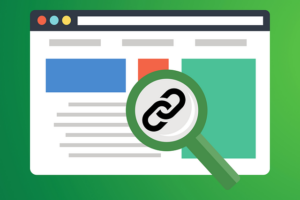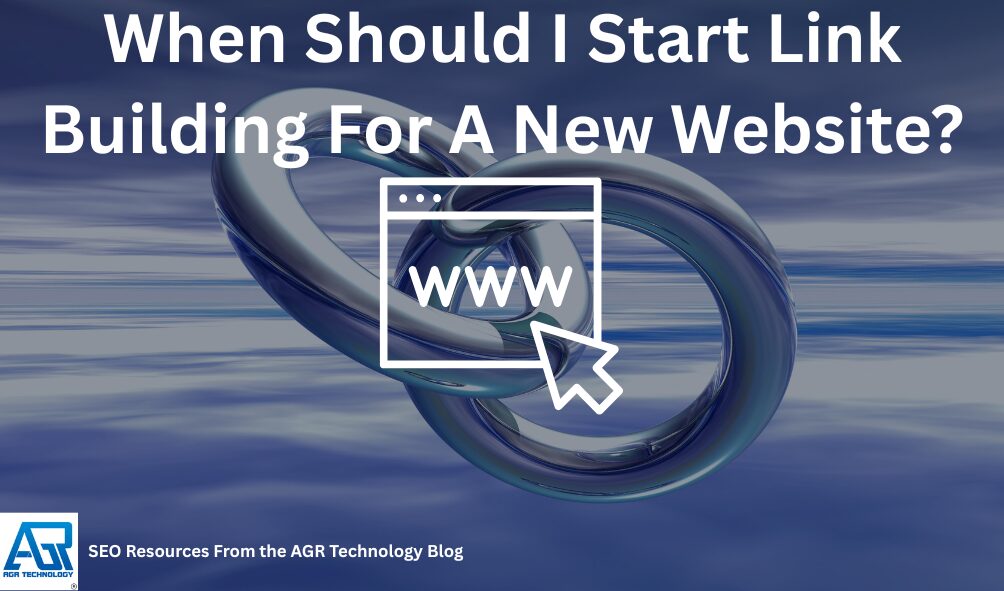If a new website is like opening the doors to a shop, link building is the buzz that tells people (and Google) it’s worth visiting. But timing matters. Start too early and the links point to thin content or technical issues. Start too late and competitors cement their lead. So, when should a business actually begin link building for a new website? The short answer: once the site is fully functional, indexed, and supported by solid technical SEO and genuinely useful content. From there, a phased, white‑hat approach sets the pace for steady growth.
AGR Technology helps businesses build authority the right way, using ethical, content‑driven link building, digital PR, and off‑page SEO strategies that align with Google’s guidelines. Below is a clear roadmap that shows what to prioritise first, how to phase outreach, and when to scale, so new sites can earn trustworthy backlinks and build domain authority without risk.
Need help with managed SEO & Linkbuilding for your business or agency? Contact AGR Technology to see how we can help
Signs You’re Ready To Start Link Building

Before asking “When should I start link building for a new website?”, it helps to confirm the site is actually ready. A few practical checks prevent wasted effort and set up cleaner, safer results.
Indexing And Basic Visibility
If core pages aren’t indexed, links won’t help much. The site should:
- Appear for branded searches and priority pages in Google.
- Show URLs in Search Console with “Indexed” status (or pending but discovered).
- Have a clean robots.txt and submitted XML sitemap.
Foundational, Link‑Worthy Content In Place
Backlinks for new websites only work when there’s something worth linking to. At minimum:
- Detailed service/product pages with clear value propositions.
- A handful of high‑quality blog posts, guides, or tools that solve real problems.
- Useful visuals, data, or checklists that others might reference.
Solid Technical And On‑Page SEO
Off‑page SEO amplifies what’s already strong. Ensure:
- Fast load speeds, mobile responsiveness, HTTPS, and logical site structure.
- Clean metadata, descriptive headings, and smart internal linking.
- No critical crawl errors or duplicate content issues.
Clear Goals, Targets, And Resources
Effective link building strategy starts with intent:
- Objectives: rankings, organic traffic, or authority growth in a niche.
- Target pages: which URLs should earn links first?
- Capacity: time, budget, tools, and ongoing outreach resources.
Timing Strategy: A Phased Roadmap For New Sites
There’s no one‑size‑fits‑all link building timeline, but most new sites benefit from a staged approach that prioritizes foundations, then outreach, then scale.
Pre‑Launch To Week 2: Establish Entity And Foundational Links
- Set up branded social profiles, Google Business Profile (if local), and key local citations.
- Publish core pages and submit sitemaps to Search Console.
- Build internal links to pass equity to priority pages.
- Light brand mentions (press page, partner listings) to establish legitimacy.
Weeks 3–8: Create Linkable Assets And Begin Light Outreach
- Produce linkable assets: in‑depth guides, statistics posts, calculators, or templates.
- Start low‑risk outreach: resource page suggestions, unlinked brand mention reclamation, niche community contributions.
- Pitch guest posts to relevant, reputable blogs, quality over quantity through quality blogger outreach
- Track indexation, impressions, and early referring domains.
Months 3–6: Expand With Strategic Campaigns
- Scale content‑driven efforts and digital PR for brand mentions and contextual links.
- Target authoritative publishers and industry associations.
- Consider collaborations, expert quotes, or original research to earn editorial links.
- Monitor anchor text diversity and keep growth natural.
After Month 6: Double Down, Diversify, And Prune
- Double down on tactics yielding the best referring domains and page‑level gains.
- Diversify link sources: industry roundups, podcasts, webinars, local sponsorships.
- Audit and disavow toxic links if necessary: maintain a healthy profile.
- Maintain a sustainable monthly cadence aligned to budget and goals.
When Starting Earlier Makes Sense
Most teams should wait until content and technical SEO are solid. But there are cases where earlier efforts are justified.
Highly Competitive Niches Or Fast‑Moving Topics
In markets where first‑mover visibility matters (e.g., finance, trending SaaS features, iGaming brands, Travel companies and others), a measured but earlier push can help establish topical authority while the content pipeline ramps up.
Migrations, Rebrands, Or Lost Link Equity
If a site has moved or rebranded, preserving and reclaiming existing links is time‑sensitive. Prioritise redirects, outreach to update old URLs, and recovery of high‑value mentions.
Local Businesses Needing Citations And Proximity Signals
Local SEOs know citations are foundational. Early, accurate listings across reputable directories and industry associations can move the needle for local packs while broader link campaigns mature.
Tactics To Use First (And What To Avoid)
New websites should lean into white‑hat link building that compounds over time and avoid shortcuts that risk penalties.
Build Entity Signals: Social Profiles, Citations, And Brand Mentions
- Claim consistent NAP (name, address, phone) across top directories and industry bodies.
- Fill out social profiles with brand messaging and links to key pages.
- Announce launches, awards, or events to earn natural mentions.
Internal Linking Before External: Pass Equity To Priority Pages
- Map internal links from high‑authority pages to bottom‑funnel URLs.
- Use descriptive, varied anchors, avoid over‑optimisation.
- Add content hubs and topical clusters to support key themes.
Low‑Risk Outreach: Resource Pages, Unlinked Mentions, And Thought Leadership
- Suggest your useful guides or tools to relevant resource pages.
- Reclaim unlinked mentions by politely asking publishers to add a link.
- Contribute expert quotes, guest posts, or data to credible publications.
Avoid Aggression: Paid Schemes, Irrelevant Links, And Spammy Velocity
- Don’t buy cheap links or blast irrelevant directories.
- Avoid sudden spikes in link velocity, build gradually and naturally.
- Steer clear of manipulative anchors: prioritise context and relevance.
Measure Impact And Decide When To Scale
Clear measurements stop guesswork. Track early signals, then scale what works.
Baseline KPIs: Indexation, Impressions, Referring Domains, And Page‑Level Gains
- Search Console: index coverage, impressions, and query growth.
- Analytics: organic sessions, landing pages, assisted conversions.
- Backlink tools: referring domains, authority metrics, link relevance.
- Page‑level ranking improvements for target keywords and URLs.
Interpret Early Signals: Quality Over Quantity
A handful of topically relevant, high‑authority links can outperform dozens of low‑quality placements. Watch for:
- Rankings improving for pages that received links.
- Better crawl rates and faster discovery of new content.
- Increased branded search as awareness grows.
Set A Sustainable Cadence: Budget, Capacity, And Diminishing Returns
- Align monthly outreach volume with content output and team capacity.
- Maintain diversity in tactics and referring domains.
- Review quarterly: prune ineffective tactics, invest more in proven channels.
Conclusion
So, when should they start link building for a new website? Once the site is indexed, technically sound, and backed by valuable, link‑worthy content, typically a few weeks after launch, with a measured ramp‑up over the first three to six months. From there, a thoughtful link building strategy that favors relevance, editorial quality, and steady growth will lift visibility, domain authority, and conversions without risking penalties.
If a business has just published a couple of posts, it’s not time to chase backlinks yet. Fix the foundations, build internal links, and create assets people actually want to reference. Then move into ethical outreach and digital PR, never paid schemes or spammy velocity.
Ready to start building your website’s authority the right way? Contact AGR Technology today for a tailored link building and SEO strategy designed to help your business rank higher and grow sustainably.
Key Takeaways
- Start link building for a new website once the site is indexed, technically sound, and backed by genuinely useful, link‑worthy content.
- Use a phased roadmap: establish entity signals and citations in weeks 0–2, create linkable assets and begin light outreach in weeks 3–8, run strategic campaigns in months 3–6, then diversify, scale, and prune after month 6.
- Prioritize white‑hat tactics—citations, internal linking, resource outreach, guest posts, and digital PR—and avoid paid link schemes, irrelevant placements, spammy velocity, and manipulative anchors.
- Begin earlier only when justified, such as in highly competitive niches, during migrations or rebrands to reclaim equity, or for local businesses needing citations and proximity signals.
- Measure impact with Search Console, analytics, and backlink tools; favor quality over quantity, watch page‑level gains, and scale outreach at a sustainable monthly cadence aligned to resources.
Frequently Asked Questions
When should I start link building for a new website?
Begin once your site is fully functional, indexed, and supported by solid technical SEO and link‑worthy content. That typically means a few weeks after launch. Start with a phased, white‑hat approach: entity signals, internal linking, light outreach, then scale as you see quality referring domains and early ranking improvements.
What are the first steps in new website link building?
Establish entity signals (social profiles, Google Business Profile, accurate citations), publish core pages, submit sitemaps, and build strong internal links to priority URLs. Then start low‑risk outreach—resource page suggestions, unlinked mention reclamation, and selective guest posts—focusing on relevance, editorial quality, and natural anchor text diversity.
What’s a safe timeline to start link building for a new website in the first six months?
Weeks 0–2: set up citations, social profiles, submit sitemaps, and build internal links. Weeks 3–8: create linkable assets and begin light outreach. Months 3–6: scale content‑driven campaigns and digital PR. Avoid sudden spikes; prioritize a steady cadence and quality over quantity as signals improve.
How many backlinks does a new website need to rank?
There’s no fixed number. Rankings depend on your niche and competitors’ link profiles. Benchmark the top results, then earn a steady trickle of relevant, authoritative links to key pages. A few high‑quality, contextual links can outperform dozens of low‑quality ones—focus on relevance, topical fit, and editorial placement.
Do nofollow links help a new website?
Yes—nofollow links can still drive referral traffic, brand visibility, and assist discovery. Google treats nofollow as a “hint,” which can sometimes aid crawling. A natural mix of dofollow and nofollow links from relevant sources is healthy; prioritize audience fit and editorial context rather than chasing only dofollow placements.

Alessio Rigoli is the founder of AGR Technology and got his start working in the IT space originally in Education and then in the private sector helping businesses in various industries. Alessio maintains the blog and is interested in a number of different topics emerging and current such as Digital marketing, Software development, Cryptocurrency/Blockchain, Cyber security, Linux and more.
Alessio Rigoli, AGR Technology
![logo-new-23[1] logo-new-23[1]](https://agrtech.com.au/wp-content/uploads/elementor/thumbs/logo-new-231-qad2sqbr9f0wlvza81xod18hkirbk9apc0elfhpco4.png)
